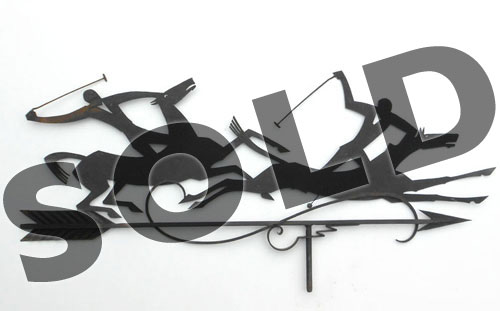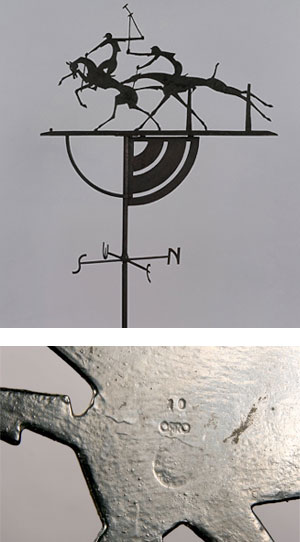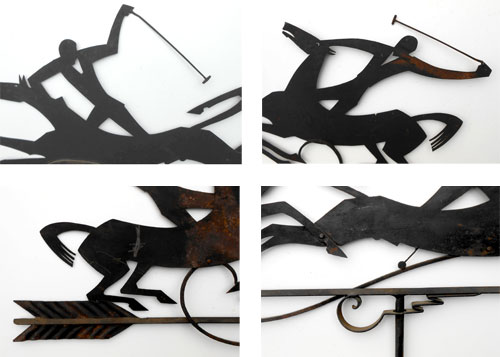|
POLO WEATHER VANE
Hunt Diederich was born in Hungary. His father was a horse trainer and his mother was the daughter of the American artist William Morris Hunt; thus his heritage neatly combined his life in art and interest in horses. Diederich produced small three-dimensional sculptures, but today he is most identified with his two-dimensional silhouette designs, which he used for paper cutouts, wood cuts, ceramics, fire screens, and, perhaps most effectively, for weather vanes. The artist himself fabricated some of these things, but Diederich also subcontracted construction to other craftsmen like the Art Metal and Iron Company, NY, who often made multiples of the same design. Diederich nothing to do with production of designs he sold to makers of everything from glass lamp bases to lady’s face-powder compacts. Additionally, his designs lend themselves to reproduction, which results in many later copies flooding the market.
This polo weather vane has an impressive provenance: Before Diederich established himself in Woodstock, NY, he was the guest at White Pines, the Byrcliffe home of Ralph Radcliffe-Whitehead, founder of the Arts and Crafts colony. During his stay there he made ceramics at the White Pines pottery facilities and may have done some metal work at the Byrdcliffe forge that was just down the hill from the Whitehead house. When Whitehead’s son Peter died in 1976 there were several chargers and other unfinished Diederich pottery in the attic among hundreds of pieces of White Pines pottery made by Jane and Ralph Radcliffe-Whitehead. There were also three weather vanes: the brass “Apollo” vane now at the Huntington Arts Collections, an aluminum panther or puma vane that retained an original price tag (Rago: Lot #139, February 2012) and the present polo vane.
It is not known if Diederich made these vanes in their entirety at the Byrdcliffe metal shop; the three vanes have identical arrows, which suggests to me that they may have been made in bulk and then adapted by Diederich for individual designs. A sheet iron version of the Apollo vane with a unique arrow was lot #99, Christie’s sale # 1487, March, 2005 and there are extent drawings for the same composition adapted for application to a fire screen. A sheet iron version of the panther vane with a standard arrow was lot #101, Nadeau, April, 2008.
Two weather vanes with a variation of the polo player design have recently been on the market, one with a maker’s mark indicating that it the artist himself did not make it. The latter vane has multiple coats of paint. Both of those vanes had been in use on building exteriors before they came to auction.
None of the three White Pines weather vanes was ever exposed to the elements and so when they were removed from the White Pines attic they retained finishes that were decades old if not original. After the panther vane was sold to a private collector in 1984, it was hung for a while on an outside fence, but the other two have been protected inside since 1976. The polo vane has a single, uneven coat of flat black, which shows some evidence of oxidization.
Diederich used the same composition of two horses and mallet-wielding riders for a wood cut and a cut paper silhouette. The woodcut was printed in the Hervey White’s Plowshare to which Diederich was a frequent contributor.
A letter certifying the provenance and signed by the heirs of Peter Whitehead’s estate accompanies the polo weather vane. |
||||||||||||





